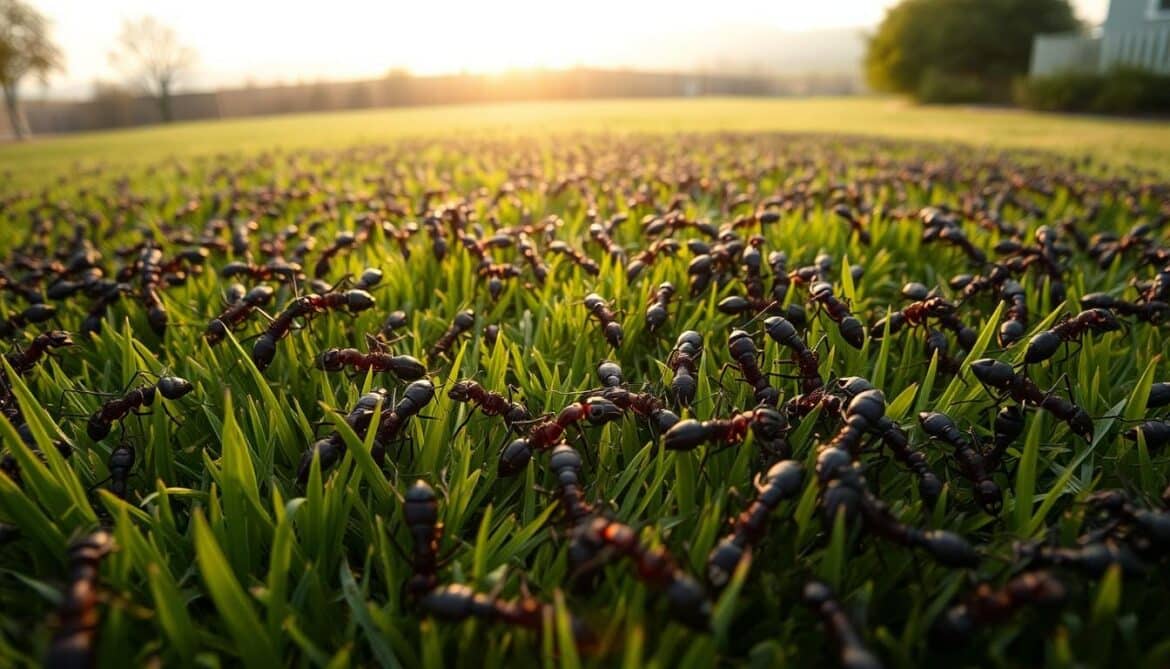A lush, well-manicured lawn is a source of pride for many homeowners in the United States. However, a common issue can disrupt this tranquility: ants. These tiny creatures can turn a serene yard into a battleground.
With hundreds of ant species across the country, understanding the scope of an infestation is crucial before attempting any pest control methods. Different species require different approaches, and some can cause significant damage to your lawn, plants, and even the structural elements of your home.
Identifying the ant species is the first step toward successful control. This comprehensive guide will explore the most common ant species, why they invade your property, and the damage they can cause. We’ll also discuss natural and chemical control methods to help you manage ants effectively.
Key Takeaways
- Understanding the scope of an ant infestation is crucial before attempting control methods.
- Different ant species require different approaches for effective control.
- Large ant infestations can damage lawns, plants, and structural elements of homes.
- Proper identification of ant species is key to successful pest control.
- Both natural and chemical control methods are available for managing ant populations.
Understanding Ants in Yard Infestation
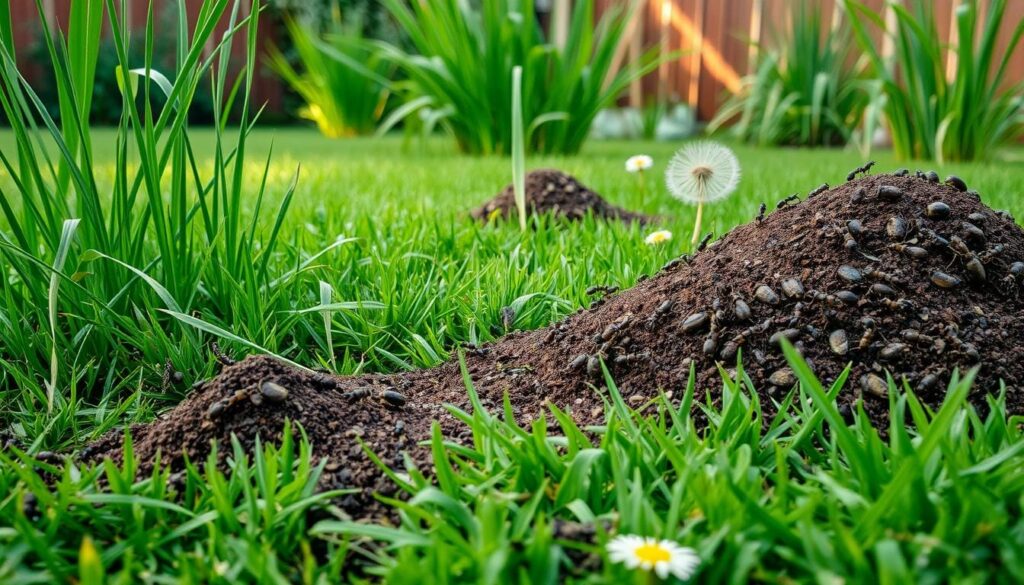
To tackle ant infestations effectively, it’s essential to comprehend the factors that attract these pests to your yard in the first place. Ants are highly social creatures that live in colonies, and their presence in your yard is often a sign of a larger issue.
Common Ant Species That Invade Yards
Several ant species are known to invade yards, each with their unique characteristics and attractions. Understanding these species is crucial for effective control.
Sugar Ants and Carpenter Ants
Sugar ants, as their name suggests, are attracted to sugary substances and are often found near food sources. On the other hand, carpenter ants are known for their ability to damage wood structures, making them a significant concern for homeowners.
Field Ants and Farming Ants
Field ants typically nest in soil and are often seen in areas with abundant food. Farming ants, also known as agricultural ants, are known to cultivate aphids for their honeydew, a sweet, sticky substance that ants find irresistible.
Why Ants Choose Your Yard
Ants are drawn to yards that offer the necessary resources for their survival. Two primary attractants are moisture and food availability.
Moisture and Water Sources
Ants need water to survive, and your yard may be providing it in various forms, from leaky pipes to standing water in bird baths. Moisture-retentive materials like mulch and decorative rocks can also contribute to the attractiveness of your yard.
Food Availability and Attractants
Different ant species are attracted to different food sources. While some ants are drawn to sugary substances, others may prefer proteins or insects. Understanding what attracts ants to your yard is key to eliminating them.
| Ant Attractant | Description | Prevention Method |
|---|---|---|
| Moisture | Leaky pipes, standing water | Fix leaks, remove standing water |
| Sugary Substances | Pet food, fallen fruit | Clean up food debris, secure pet food |
| Protein Sources | Insects, pet food | Seal entry points, remove debris |
How Ants Damage Your Yard and Home
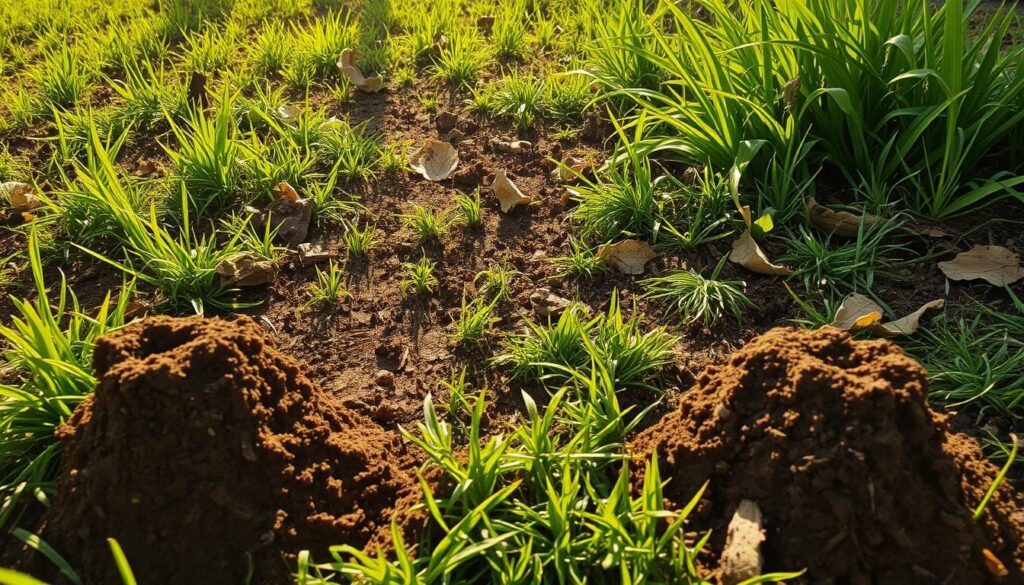
Yard infestation by ants can result in considerable harm to both your lawn and the structural integrity of your home. Ants are not just a nuisance; they can cause significant damage that may lead to costly repairs if left unchecked.
Structural Damage to Lawn and Plants
Ants can cause structural damage to your lawn and plants primarily through their nesting activities. Ant mounds can disrupt the soil and root systems of plants.
Ant Mounds and Root Disruption
When ants create their mounds, they can damage the roots of plants and grass, leading to unhealthy or dead patches in your lawn. This disruption can also make your lawn more susceptible to erosion.
Relationship with Other Harmful Pests
Some ant species, like carpenter ants, can facilitate the presence of other harmful pests. For instance, they can protect aphids and other sap-sucking insects from natural predators, leading to further damage to your plants.
Potential Threats to Your Property
Beyond lawn damage, ants can pose significant threats to your property. Certain ant species can cause substantial harm to your home’s structure and pose health risks to your family and pets.
Carpenter Ant Damage to Wooden Structures
Carpenter ants are known to excavate wood to create nesting galleries, weakening the structural integrity of wooden structures over time. This can lead to significant repair costs if not addressed.
- Carpenter ants target wood softened by moisture or decay.
- The damage can affect load-bearing structures if left untreated.
Fire Ant Risks to Pets and Family
Fire ants are a serious health risk, especially in southern states. Their stings can cause severe allergic reactions and are particularly dangerous for pets who may disturb their nests.
- Fire ants can cause painful stings that may require medical attention.
- Pets are vulnerable to fire ant attacks when exploring the yard.
Natural Methods to Eliminate Ants in Your Yard
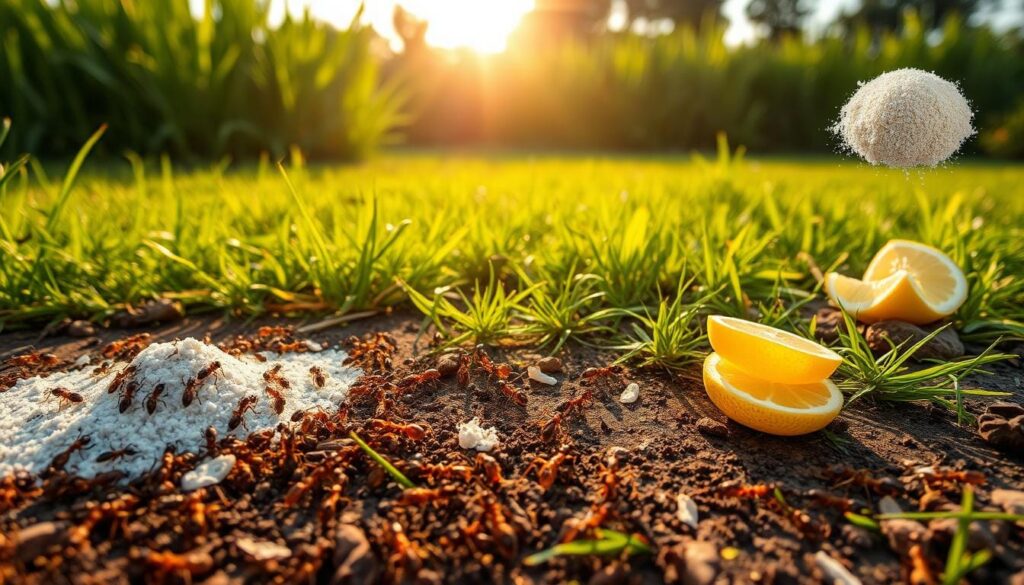
Natural ant control is a viable solution for yard infestations, offering a range of methods to rid ants without harsh chemicals. These methods not only help in eliminating ants but also ensure the safety of your family, pets, and the environment.
Household Ingredient Solutions
Several common household ingredients can be used to get rid of ants in your yard. These ingredients are often readily available and can be used in various combinations to achieve the desired effect.
Vinegar and Dish Soap Sprays
A mixture of vinegar and dish soap can be an effective spray to deter ants. The acidity in vinegar disrupts ant trails, while dish soap helps in sticking to the ants, ultimately killing them.
Boiling Water and Diatomaceous Earth
Pouring boiling water directly on ant nests can be an effective way to kill ants. Additionally, diatomaceous earth, a natural powder, can be used to dehydrate and kill ants.
Borax and Baking Soda Baits
A mixture of borax and baking soda can be used as a bait to attract and kill ants. Ants are drawn to the bait, which they then carry back to their colony, ultimately killing the queen and the rest of the ants.
Natural Repellents and Barriers
In addition to eliminating ants, creating barriers and using repellents can help prevent future infestations. Certain natural substances can deter ants from entering your yard.
Essential Oils and Spices
Essential oils such as peppermint, tea tree, and cedarwood, along with spices like cinnamon and cayenne pepper, can be used to repel ants. These substances interfere with ant communication and navigation, making it difficult for them to traverse areas where they are applied.
Creating Effective Perimeter Barriers
To get rid of ants for good, creating a perimeter barrier around your home and yard is crucial. Using natural repellents like vinegar, cinnamon, and essential oils, you can create a barrier that ants are reluctant to cross. This barrier should be applied consistently and reapplied after rain or irrigation.
Chemical Control Methods for Stubborn Infestations
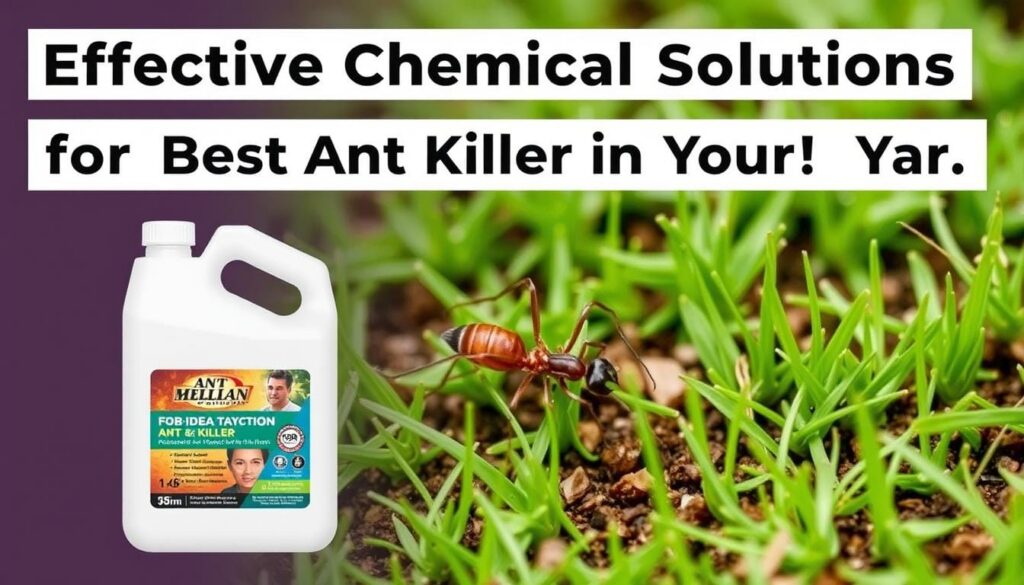
When natural methods fail, chemical control becomes the next line of defense against stubborn ant infestations. Chemical control methods can be highly effective in eliminating ants that have invaded your yard.
Commercial Ant Baits and How They Work
Commercial ant baits are a popular chemical control method. They work by attracting ants with a substance that contains a slow-acting poison. The ants then carry this poison back to their colony, effectively killing the queen and eventually the rest of the colony.
Indoor vs. Outdoor Bait Stations
The choice between indoor and outdoor bait stations depends on the location of the ant infestation. Indoor bait stations are ideal for areas inside your home where ants are seen, while outdoor stations are better suited for yard infestations.
Targeting the Queen and Colony
To effectively eliminate an ant colony, it’s crucial to target the queen. Baits that are carried back to the nest and fed to the queen can effectively kill her, leading to the collapse of the colony.
Insecticides and Application Techniques
In addition to baits, insecticides can be used to directly kill ants. Liquid and granular insecticides are available, each with its own application techniques and benefits.
Liquid vs. Granular Products
Liquid insecticides provide immediate coverage and are ideal for perimeter treatments. Granular products, on the other hand, offer longer-lasting protection and are effective for treating large yard areas.
Safe Application Practices
It’s essential to follow the instructions on the label carefully and take necessary precautions, such as wearing protective gear, to ensure safe application.
By understanding the different chemical control methods available, homeowners can effectively manage stubborn ant infestations and protect their yards.
Preventing Future Ant Infestations
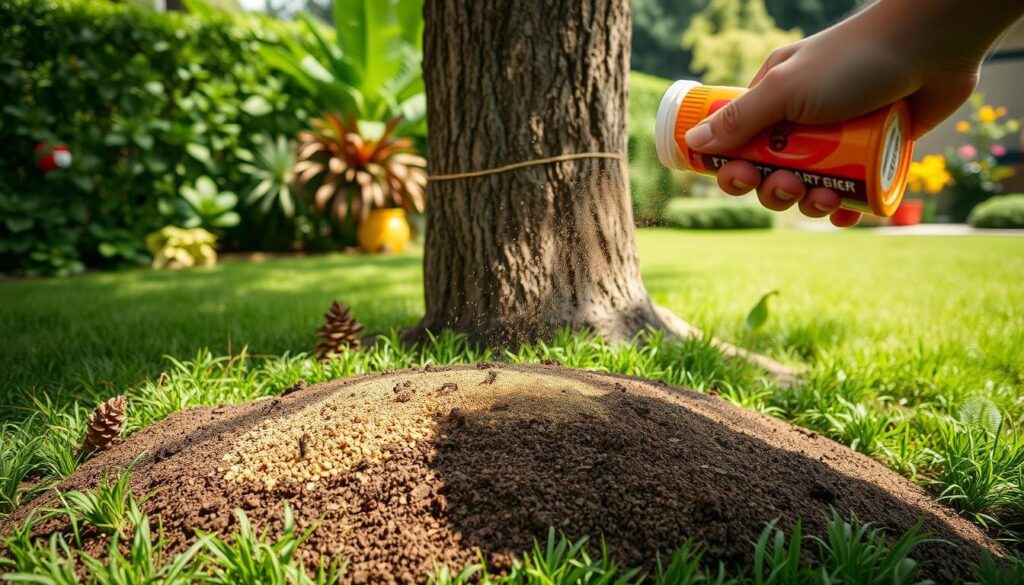
Preventing future ant infestations requires a multi-faceted approach that includes maintaining a healthy lawn and eliminating attractants. By adopting a combination of strategies, you can significantly reduce the likelihood of ants invading your yard.
Lawn Care Strategies
Maintaining a healthy lawn is crucial for preventing ant infestations. Proper lawn care involves several key practices.
Proper Mowing and Watering Practices
Regular mowing and appropriate watering practices are essential. Mowing your lawn at the recommended height for your grass type and watering it deeply but infrequently encourages deep root growth, making it less hospitable to ants.
Fertilization and Aeration Benefits
Fertilizing your lawn as needed and aerating it annually can improve soil health, making it less conducive to ant infestations. Healthy, dense grass outcompetes weeds and reduces the likelihood of ant colonies.
| Lawn Care Practice | Benefit |
|---|---|
| Regular Mowing | Promotes healthy grass growth |
| Proper Watering | Encourages deep root growth |
| Fertilization | Improves soil health |
| Aeration | Reduces soil compaction |
Eliminating Attractants
Eliminating attractants is equally important in preventing ant infestations. This involves managing food and water sources and making strategic landscape modifications.
Managing Food and Water Sources
Keep your yard free of food debris and standing water. Regularly clean up outdoor dining areas, secure trash cans, and fix leaky faucets. For more detailed strategies on preventing ant infestations, visit Birch Fumigators for expert advice.
Landscape Modifications
Modify your landscape to discourage ant nesting. Create buffer zones between your home’s foundation and mulched areas, reduce mulch thickness, and remove dead wood and debris. Consider using natural repellents like diatomaceous earth or cayenne pepper around the perimeter of your yard.
By implementing these strategies and maintaining consistency over time, you can enjoy a yard with minimal ant activity. It’s about creating an environment that is not conducive to ant infestations.
Conclusion: When to Call Professional Pest Control
Not all ant infestations can be solved with DIY methods; knowing when to call a pro is essential. If you notice even one ant hill in your yard, it’s likely a larger problem is lurking beneath the surface. An exterminator will assess the size of the problem and its source, recommending the best course of treatment to ensure that the ants are gone for good.
Certain situations warrant professional pest control intervention, particularly when colonies are extensive or located in inaccessible areas. Professional pest control teams have access to commercial-grade products and equipment, allowing them to treat severe infestations more effectively. If you’ve attempted multiple DIY treatments without success, it’s time to consult with a professional pest control service to eliminate the ants and protect your home and yard.
